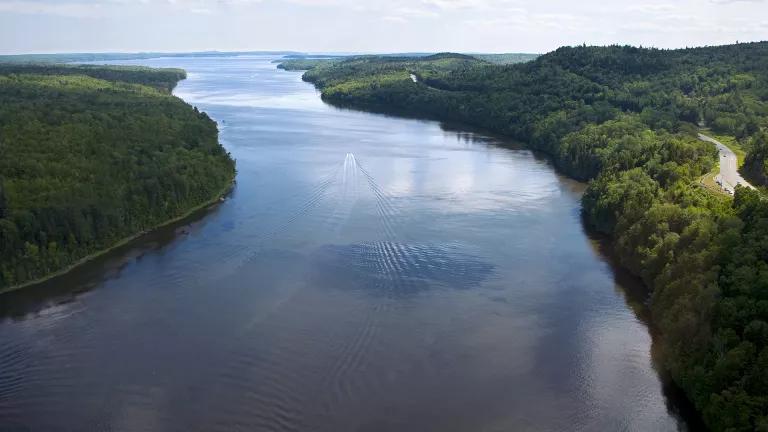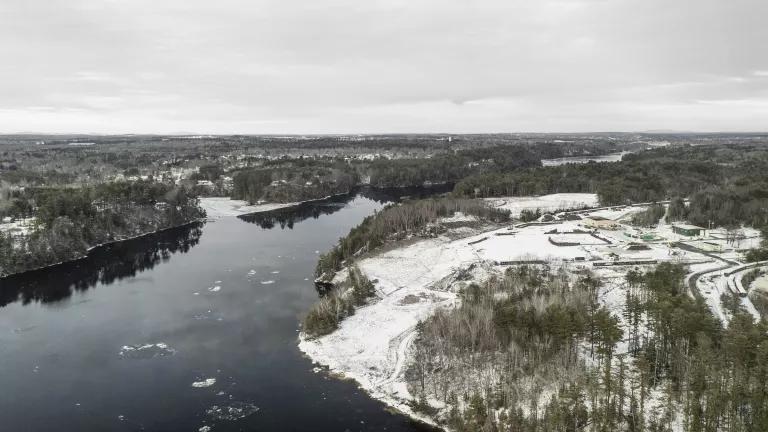Maine People’s Alliance and NRDC v. HoltraChem Manufacturing Co. LLC, and Mallinckrodt US LLC
Case Status
ActiveLast Update

For more than 50 years, Maine’s Penobscot River has been contaminated with tons of mercury from a now-shuttered chemical plant in Orrington. But on October 11, 2022—following two decades of legal battles to address the contamination—a federal district court approved a settlement, setting in motion a cleanup plan, long-term monitoring, and funding for projects that will benefit the environment and communities affected by the pollution. Mallinckrodt US LLC, a former owner and operator of the plant, must pay $187 million, and up to $267 million, to independent trusts that will fund and direct these remediation activities.
Background
Mercury in the environment is converted by bacteria into methylmercury, a potent neurotoxin that’s particularly harmful to the developing brain of a child or fetus. In 2000, NRDC and the Maine People’s Alliance sued Mallinckrodt to seek a cleanup of the mercury in the Penobscot River that had persisted for decades.
After a trial in 2002, the federal district court in Maine held that mercury in the Penobscot River could present an imminent and substantial threat to public health and the environment. The judge ordered Mallinckrodt to fund an independent study to determine if remediation was necessary and feasible and, if so, to develop a precise plan to fix the situation. The district court’s decision was upheld on appeal in 2006.
Over nine years, a panel of three mercury experts appointed by the court studied the Penobscot and submitted three reports, all confirming that the river and estuary contain elevated mercury levels, putting wildlife, as well as humans who eat seafood and waterfowl, at risk. Several species, including lobsters, black ducks, eels, and marsh songbirds, were found to have high mercury levels. The panel also concluded that the rate of natural recovery was too slow: it would take 22 to 77 years for mercury levels to be reduced by half in various parts of the Penobscot system, and 106 to 390 years for mercury concentrations to decline to levels similar to natural background concentrations. As a result, the experts recommended establishing a remediation program to evaluate and implement active measures to speed up the river’s recovery. In response to these data, the State of Maine issued a consumption advisory for waterfowl along the lower Penobscot. The state also closed a seven-square-mile portion of the lobster and crab fishery at the mouth of the river and expanded the closure by about five and a half square miles in 2016 after conducting additional sampling.
In June 2014, the federal district court in Maine held a 19-day trial to evaluate the panel’s recommendations. In September 2015, the judge accepted the recommendation to proceed with a remediation study and ordered the appointment of an engineering firm to evaluate and propose potential solutions to clean up the remaining mercury in the Penobscot.
The engineering firm selected by the court in January 2016 evaluated potential remediation options, produced numerous technical reports, and completed its final report and recommendations in September 2018. The engineers recommended that the court order a suite of active remedies to address portions of the Penobscot River. The remedies include dredging, thin layer capping, and long-term monitoring—along with an adaptive management approach that considers additional remedies if the initial remedies are insufficient. The engineering firm maintains a community involvement website to inform the public about its study
On March 19, 2021, NRDC, Maine People’s Alliance, and Mallinckrodt filed a proposed consent decree to settle the case. The Court held a three-day fairness hearing in October 2021 to receive evidence and testimony regarding the proposed settlement, and it officially approved the settlement on October 11, 2022. The settlement provides that Mallinckrodt will pay $187 million, and up to $267 million, to independent trusts that will fund and implement remediation and restoration work. This work will accelerate recovery of the Penobscot and make a real difference for the ecosystem, the fish and wildlife, and the people who rely on them.
Additional information about the settlement is available at PenobscotRiverRemediation.com. More on the ceaseless drive of local advocates and NRDC’s decades-long involvement in our story here.
Case Documents
Complaint (PDF) Memorandum of Decision and Order (PDF) Implementing Order for Penobscot River Study Pursuant to Memorandum of Decision and Order Dated July 29, 2002 (PDF) Order Amending Implementing Order for Penobscot River Study (PDF) Second Order Amending Implementing Order for Penobscot River Study (PDF) Opinion of the United States Court of Appeals for the First Circuit (PDF) Penobscot River Mercury Study: Phase I of the Study, 2006-2007 (PDF) Order Approving Phase I Report (PDF) Penobscot River Mercury Study: Update to the Phase I Report (PDF) Notice of Electronic Filing of Phase II Report (PDF) Executive Summary: Penobscot River Mercury Study Final Report, April 2013 (PDF) Phase II Report Chapter 1. A Synthesis of Mercury Studies on the Penobscot River Estuary (PDF) Phase II Report Chapter 2. Setting Mercury Remediation Targets for Surface Sediments in the Penobscot Estuary (PDF) Phase II Report Chapter 3. Total Mercury Loading to the Penobscot River from the HoltraChem Plant Site, Orrington, Maine and from Other Point Sources (PDF) Phase II Report Chapter 4. Field Data and Experiments on in situ Particle Formation in the Penobscot River (PDF) Phase II Report Chapter 5. Total Mercury Sedimentary Inventories and Sedimentary Fluxes in the Lower Penobscot River and Estuary, Maine (PDF) Phase II Report Chapter 6. Estimates of Recovery from Mercury Contamination in the Penobscot River Estuarine System by an Assessment of Sedimentation Rates (PDF) Phase II Report Chapter 7. Field Investigations of Hydrodynamics and Particle Transport in Penobscot River and Bay (PDF) Phase II Report Chapter 8. Total and Methyl Mercury Concentrations in Mobile and Surface Sediments in the Upper Penobscot Estuary (PDF) Phase II Report Chapter 9. Upstream Limit of Mercury Contamination in Surface Sediments (PDF) Phase II Report Chapter 10. Investigation of Total and Methyl Hg Export from Mendall Marsh Via South Branch of Marsh River, a Tributary to the Penobscot River (PDF) Phase II Report Chapter 11. Mercury Methylation Studies: Distribution and Biogeochemical Controls on Net Methylmercury Production in Penobscot River Marshes and Sediments, 2009-2012 (PDF) Phase II Report Chapter 12. Factors Controlling Methyl Mercury Production in Intertidal, Wetland and Bay Sediments in the Penobscot Estuary (PDF) Phase II Report Chapter 13. Plan for Long Term Monitoring of Mercury in Sediments and Biota in Penobscot River and Bay (PDF) Phase II Report Chapter 14. Temporal and Geographic Trends in Mercury in Biota in the Penobscot Estuary (PDF) Phase II Report Chapter 15. Temporal trends of total and methyl mercury in surface sediments, 2006-2010 (PDF) Phase II Report Chapter 16. Analysis of Aquatic and Wetland Food Webs in the Penobscot Estuary (PDF) Phase II Report Chapter 17. Background Concentrations of Mercury in Central Maine Estuaries (PDF) Phase II Report Chapter 18. Simulations of the Rate of Decline of Mercury Concentrations in the Penobscot Estuary (PDF) Phase II Report Chapter 19. In-situ Amendment Plot Studies (PDF) Phase II Report Chapter 20. Investigation of Two Materials for Potential Application in Reducing Filter-passing Mercury in the Penobscot River (PDF) Phase II Report Chapter 21. Recommendations to the Court (PDF) Phase II Report Chapter 22. Risk Overview (PDF) Phase II Report Chapter 23. The Scientific Basis for Active Remediation of the Upper Penobscot Estuary (PDF) Phase II Report Errata (PDF) Penobscot River Mercury Study: Results of 2012 Monitoring (PDF) Penobscot River Mercury Study: Results of 2012 Monitoring – Figures 1-81 (PDF) Penobscot River Mercury Study: Results of 2012 Monitoring – Tables 1-17 (PDF) Penobscot River Mercury Study: Results of 2012 Monitoring – Appendices 1-11 (PDF) Penobscot River Mercury Study: Monitoring Mercury in American Black Ducks, 2013-2014 (PDF) Plaintiffs’ Pre-Trial Brief (PDF) Mallinckrodt US LLC’s Pre-Trial Brief (PDF) Plaintiffs’ Post-Trial Brief (PDF) Appendix A: Witness Summaries Submitted by the Plaintiff (PDF) Mallinckrodt US LLC’s Post-Trial Brief (PDF) Appendix A: Witness Summaries Submitted by the Defendants (PDF) Plaintiff’s Post-Trial Reply Brief (PDF) Order on Remediation Plan (PDF) Order on Evaluation of Potential Active Remedies (PDF) Selection of Phase III Engineering Firm (PDF) Penobscot River System Phase III Engineering Study Factsheet Phase III Engineering Study Report (September 2018) Proposed Consent Decree (PDF) Motion to Approve Consent Decree (PDF) Public Notice of Court Fairness Hearing and Opportunity to Comment (PDF) Fact Sheet: Proposed Penobscot River Mercury Cleanup (PDF) Order on Consent Decree and Proposed Bar Order (PDF) Endorsed Consent Decree (PDF)Related Content

Proposed Settlement Aims to Clean Up Mercury in the Penobscot River Estuary

A 22-Year Court Battle Ends with Justice for the Penobscot River

